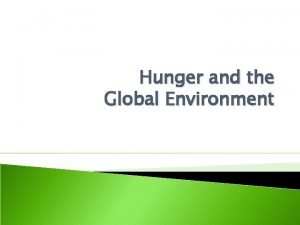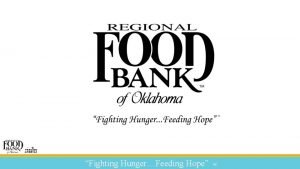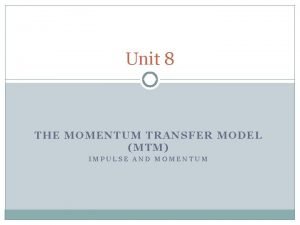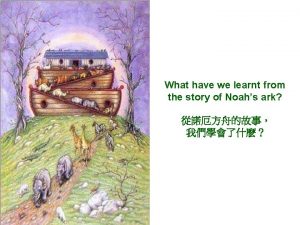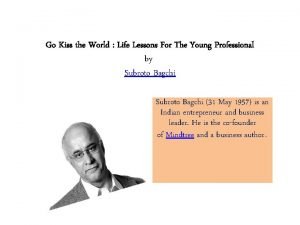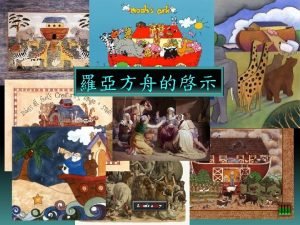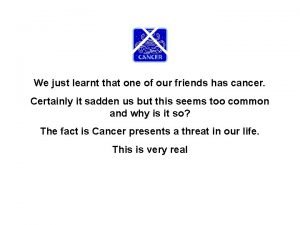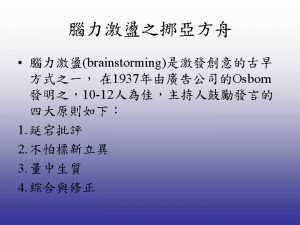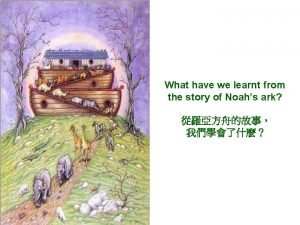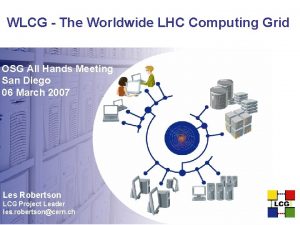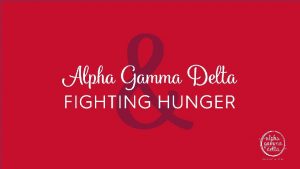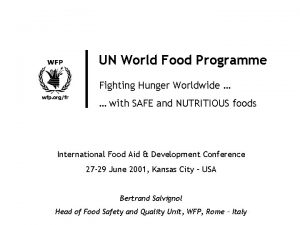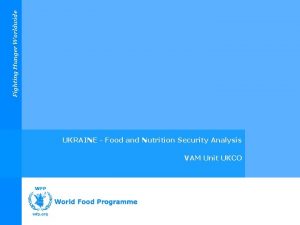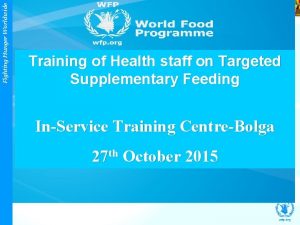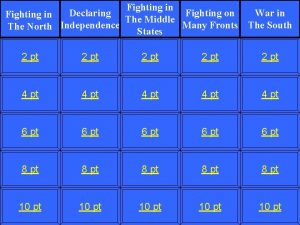Fighting Hunger Worldwide Lessons learnt on the use











- Slides: 11

Fighting Hunger Worldwide Lessons learnt on the use of Acha Mum and Wawa Mum

Fighting Hunger Worldwide Background: • WFP is considering importing ‘Acha. Mum’ and ‘Wawa. Mum’, chickpea containing lipid-based ready-to-use-food (RUSF and LNS-MQ) products for the treatment and prevention of moderate acute malnutrition (MAM). • Acha. Mum would replace the peanut containing RUSF Plumpy Sup • Wawa. Mum the peanut containing LNS-MQ Plumpy’ Doz

Fighting Hunger Worldwide Product Comparison: Acha. Mam Plumpy Sup Weight (g) 100 g 92 g* Type of product Lipid-base Nutrient Supplement (LNS) Treatment Dose 1 sachet For 60 -90 days Target Group Children 6 -59 months Total Kilocalories 520 kcal/sachet 500 Kcal/sachet Protein (g) 13 g Fat 31 g Key Ingredients Chickpeas (roasted), vegetable oils, non hydrogenated vegetable fat skimmed milk powder, sugar, vitamins (palm, rapeseed), sugar, soy flour, & minerals, emulsifier and antioxidants. peanuts, whey powder, vitamin and mineral complex, stabilizer: hydrogenated vegetable fat, cocoa, emulsifier: mono and diglycerides, vegetable lecithin (soy or sunflower). Shelf-life 24 months Packaging Per Carton: sachets** Price/Kcal $0. 18 USD 1, 818 / MT # 24 months 10. 5 kg (net) & 105 *New specification this will be 100 g **New specification: 150 sachets per carton; 15 kg (net) # Price on January 21, 2016 Per Carton: sachets ** 13. 8 kg (net) & $0. 23 /sachet; USD 2, 450 / MT # 150

Why is WFP proposing a change in product for the treatment and prevention of MAM? • • Fighting Hunger Worldwide • • Lower price with equal benefits. Specialized nutritious foods are relatively costly. Suppliers in Pakistan produce RUSF and LNS-MQ, which contain chickpeas instead of peanuts, with the same nutritional content for a substantially lower price. A lower cost product allows WFP to treat more children with limited resources. Lower risk of aflatoxin contamination. Using a different protein source than peanuts facilitates local sourcing of ingredients, because other crops, such as chickpeas are much less prone to aflatoxin contamination. Diversifying the supplier base provides more flexibility. Currently, WFP heavily relies on one main supplier for RUSF and LNS-MQ, which makes our pipeline vulnerable in case the supplier experiences issues that reduce their capacity to deliver, and it can also restrain our ability to swiftly respond in case of an emergency. Increasing the supplier base reduces vulnerability and increases flexibility. Broader options increase competitive bidding, which reduces price. There are few suppliers of LNS, which limits competitive pricing. By increasing the supplier’s base with producers of other LNS type products, more flexibility and competition can be created.

Fighting Hunger Worldwide Why do some lipid-based products (LNS) for managing malnutrition include chickpea instead of peanuts? • Different LNS recipes are being developed for several reasons, including using locally available and acceptable ingredients and lowering the risk of aflatoxin contamination. • Apart from chickpeas, other ingredients that are being considered, but not yet used at scale, include a combination of rice and lentils (Bangladesh) and almonds (Afghanistan).

Fighting Hunger Worldwide Where are chickpea-containing LNS products produced and consumed? • LNS recipes made with chickpeas have been developed in Bangladesh, Ethiopia, India and Pakistan. Production occurs at the largest scale in Pakistan. • There are three producers in Pakistan as there is a high demand based on the large scale of programming in the country. • The RUSF, for MAM treatment, is known by its Pakistani name: Acha. Mum and the LNS-MQ for prevention of acute malnutrition is known as Wawa. Mum.

Fighting Hunger Worldwide Is the nutritional value of chickpea-containing products similar to peanut-containing products and do chickpeacontaining products comply with WHO guidance for foods for treating acute malnutrition? • Yes, the nutrient values of chickpea-containing products are similar to peanut-containing products. RUSF containing chickpeas, also complies with the WHO technical note on the composition of foods for treating MAM. • It is important to note that WHO guidance specifies the energy and nutrient density and recommends the inclusion of milk powder and does not otherwise include or exclude specific ingredients. Of course, all products need to be appropriately processed, be safe for consumption, have a good shelf-life, and taste needs to be acceptable to the consumers.

Fighting Hunger Worldwide How does Acha. Mum relate to the global harmonization of nutritious products that is lead by UNICEF, WFP and USAID? An interagency harmonization process is underway among the main buyers of RUTF, RUSF and LNS-MQ, i. e. UNICEF, WFP and USAID. This will be announced early in 2016 and will lead to the following: • Harmonized nutritional value • Harmonized packaging: all will be in sachets (no more use of pots) and their will be a uniform color band on sachets of a particular product type: – Red for RUTF – Orange for RUSF – Yellow for LNS-MQ

Fighting Hunger Worldwide Acceptability A total of five studies have assessed the acceptability of chickpea RUSF. • Two studies assessed acceptance of Acha. Mum and Wawa. Mum. In Pakistan, 36 healthy children aged 6 -24 months consumed the product for 21 days. Mean intake was 37 -39 g (200 -212 kcal) per meal. The caretakers scored the product positively for taste, texture, color and smell. In Egypt (3), 50 children aged 6 -24 months participated for 6 days during a 12 day period, and their intake increased gradually from. 26. 5 g, 28. 5 g, 30 g, 33. 5 g, 35 g to 36 g on days 1 -6, respectively. Their caretakers also rated the product positively for the three assessed attributes: texture, smell and appearance. • In Bangladesh, a clinical trial was conducted among 90 children aged 6– 18 months in a slum of Dhaka city. Two LNS products were developed, one containing ricelentils and the other one chickpeas (similar to Wawa. Mum). The acceptability of both products was compared to Pushti (a cereal based food supplement). An average intake of 23. 8 g (126 kcal) of the rice-lentils and 28. 4 g (152 kcal) of the chickpeas LNS product was reported. For Pushti, an average consumption of 17. 1 g (64 kcal) was found. Among mothers, both RUSFs were more liked compared to Pushti. • In Ethiopia two studies assessed acceptability of chickpea RUSF. One assessed the acceptability of four different recipes among 140 children suffering from MAM from five different regions. The recipes, which contained chickpeas, chickpeas + soy, chickpeas +maize, chickpeas + soy + maize, were all well accepted with an average intake of 29. 3 g/meal and the caretakers liked them as well. The other study assessed the acceptability of a chickpea-sesame based RUSF (6) among 53 children aged 6 -7 years. The children consumed 223. 5 g/d (1194 kcals/d), indicating that they really liked the product.

Fighting Hunger Worldwide Evidence base of chickpea-containing products for management of malnutrition • RUSF containing chickpeas complies with the WHO technical note in terms of nutrient content, it can be used for MAM treatment. • MAM programs in Pakistan are using Acha. Mum and report recovery figures that are within the range of those reported by MAM programs that use RUSF that contains peanuts. • It is important to note that treatment success is much more dependent on other factors, such as coverage, compliance, treatment of illness, good relationship between caretaker and service provider and other factors, rather than any small differences in terms of the composition of the RUSF. • A study in Bangladesh that provided different kinds of LNS-MQ for preventing malnutrition, including peanut-, chickpea-, and rice/lentil-formulations, found a reduction of stunting prevalence in the product groups compared to the nutrition education only group, and there was no difference among the different products.

Fighting Hunger Worldwide Interchangeability of chickpea- and peanut -containing LNS Using the peanut- and chickpea-containing products interchangeably would be possible from the point of view of: • Nutritional value, as it complies with required composition for MAM treatment • Packaging, as this will be harmonized across suppliers, irrespective of specific ingredients, with one color code per product type (i. e. RUTF, RUSF and LNS-MQ)
 Worldwide one person in every experiences persistent hunger
Worldwide one person in every experiences persistent hunger Fighting hunger feeding hope
Fighting hunger feeding hope Impulse momentum bar chart
Impulse momentum bar chart What have we learnt from the story
What have we learnt from the story Go and kiss the world mcq
Go and kiss the world mcq What have we learnt from the story
What have we learnt from the story Ravi poured the milk for the kitten that he brought from
Ravi poured the milk for the kitten that he brought from What have you learnt from the story
What have you learnt from the story Just learnt that
Just learnt that What have we learnt from the story?
What have we learnt from the story? What have we learnt from the story? *
What have we learnt from the story? * Worldwide lhc computing grid
Worldwide lhc computing grid
